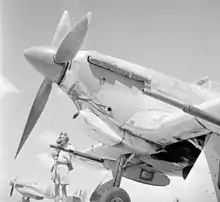Vickers S
The Vickers Class "S" was a 40 mm (1.57 in) cannon used to arm British aircraft for attacking ground targets in the Second World War.
| Vickers S | |
|---|---|
 A Hawker Hurricane fitted with two S-gun Shandur, Egypt (1942) | |
| Service history | |
| Used by | Royal Air Force |
| Wars | Second World War |
| Production history | |
| Produced | 1942 |
| Variants | Mk 1, Mk 2 |
| Specifications | |
| Mass | 320 lb (134 kg) |
| Length | 9 ft 9 inches (2.97 m) |
| Barrel length | 5 ft 7 in (1.7 m) |
| Cartridge weight | 4 lb (1.8 kg) 40x158R |
| Calibre | 40 mm (1.6 in) |
| Rate of fire | 100 rounds/min |
| Muzzle velocity | 1,870 ft/s (569.98 m/s) with 3lb shot |
| Feed system | 12-round drum later 15 rounds |
History
The Vickers Class "S" 40 mm (1.57 in) gun was developed in the late 1930s as an aircraft weapon. The ammunition was based on the 40x158R cartridge case of the naval 2 pdr Anti-aircraft gun (the "Pom-pom"). The weapon was a long-recoil design derived from the 37 mm 1½pdr "COW gun" from Coventry Ordnance Works.The gun was originally intended as a bomber defensive weapon and was tested as such in a turret fitted to a modified Vickers Wellington II. This was not adopted for service, but when the need to attack tanks from the air was identified, the "S" gun was chosen and special armour-piercing ammunition developed.[1]
Combat history
The only aircraft built to carry the Vickers S were ground attack variants of the Hawker Hurricane. Mark IID and Mark IV Hurricanes could mount one under each wing, in conformal gun pods.
No. 6 Squadron RAF operated the Hurricane IID in North Africa from mid-1942. Claims by pilots using the Vickers S included 47 tanks destroyed (of 148 tanks hit), as well as nearly 200 other vehicles. However, the Hurricane IID was poorly armoured for the ground attack role and ground fire caused heavy losses. In addition, 40 mm ammunition was seldom effective against vehicles as well-armoured as the Tiger I tank.
Mark IV Hurricanes (operational from 1943) had improved armour around their engine, cockpit and fuel tanks.
From 1944, Hurricanes armed with the Vickers S served in the South East Asian theatre. In most cases HE ammunition was used against road vehicles and river craft.
Assessments carried out in South East Asia showed a relatively high level of accuracy: an average of 25% of shots fired at tanks hit their target. (By comparison, RP-3 60 pound rocket projectiles only 5% against tank-sized targets.) However, 40 mm HE rounds were twice as accurate as AP rounds, possibly because the lighter weight and higher velocity of the HE round gave it ballistics similar to that of the .303 in (7.7 mm) Browning machine gun that were used for sighting.
See also
Weapons of comparable role, performance and era
- 2-pounder gun Mark XIV : a rival to the Vickers S developed by Rolls Royce
- Bordkanone BK 3,7, 37-mm the closest German equivalent used by the WW II Luftwaffe
- Nudelman-Suranov NS-45 : 45mm Soviet equivalent (up-bored from prior 37-mm design)
- Ho-203 : 37mm Japanese cannon equipped on Kawasaki Ki-45 fighters/fighter-bombers.
- Ho-301 : 40mm Japanese cannon equipped on some Nakajima Ki-44 fighters (was not used for ground attack, it was used for bomber interception.)
References
- Wallace, G.F. (1972). "10, The 40mm Guns". The Guns of the Royal Air Force 1939-1945. London: William Kimber. ISBN 0-7183-0362-8.
External links
| Wikimedia Commons has media related to Vickers S. |
- Anthony G Williams, 37MM AND 40MM GUNS IN BRITISH SERVICE